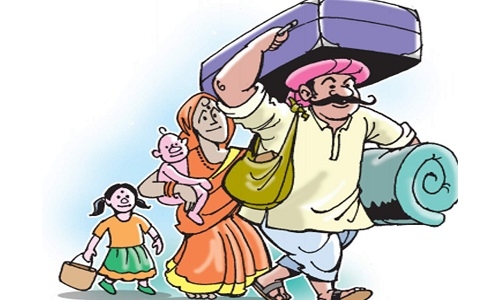30,000 migrations witnessed from State
| Date :30-Nov-2023 |

Staff Reporter
Bhilai,
In the fiscal year 2022-23, Chhattisgarh witnessed a substantial migration of around 30,000 individuals, primarily comprising workers, to various states, while approximately 19,500 people from other states flocked to Chhattisgarh for employment opportunities. The Central Monitoring System’s latest report sheds light on the dynamics and challenges associated with this migration trend. Chhattisgarh residents, particularly workers and students, migrated predominantly to Southern States, Maharashtra, Gujarat, Punjab, and Delhi-NCR in pursuit of better job prospects. Notably, migrants from Jharkhand exhibited a significant shift to various districts within Chhattisgarh for improved work opportunities. The report highlights that a substantial number of workers from rural areas migrated to districts in Punjab for agricultural labour and to states like Maharashtra, Gujarat, Andhra Pradesh, and Karnataka for employment in the construction sector.
Migration occurred both as permanent relocation and temporary stays, ranging from a few months to longer durations. Concerningly, around 290 workers faced difficult circumstances and were rescued from other states following complaints of mistreatment by agents and employers. Tragically, 43 migrants lost their lives in the process, underlining the hardships faced by many during migration. The report emphasises the role of labour contractors who received licenses from the State Government to engage workers in different sectors across states.
Bilaspur district had the highest number of inter- state migrant workers, followed by Raipur, Mahasamund, Durg, and Rajnandgaon, while some districts in Bastar Division reported zero migration. Sociologist Dr P K Sharma expressed concern over the underreporting of migration, urging the administration to ensure that every individual working outside the State registers under the Interstate Migrant Workmen Act 1979. Dr Sapna Sharma highlighted the economic motivations behind migration, citing the need for thorough document checks of agents to prevent exploitation.
Educated youngsters are also contributing to the migration trend, seeking better opportunities in states where they can earn more, especially in the construction, hospitality, and health sectors. Dr Sapna Sharma emphasised the need for authorities to prevent exploitation in the wake of low payments in Chhattisgarh. As the State grapples with the challenges posed by increasing migration, experts underline the importance of effective regulation and oversight to safeguard the rights and well-being of the migrant population



